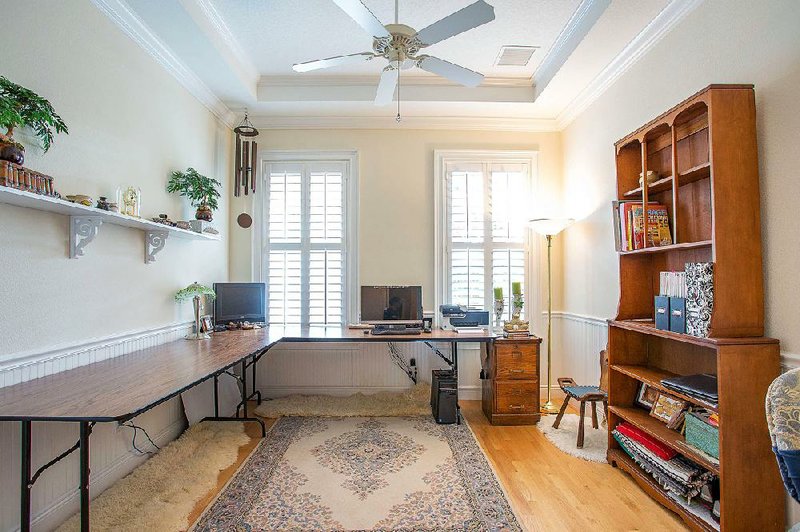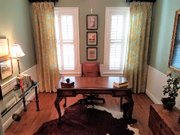I've heard designers say a billion times: The best home interiors reflect those who live there.
Uhhh, I want to add, that all depends who lives there.
Even though I agree in spirit with this comment, I have seen many interiors that are dreadful -- precisely because they reflect their inhabitants a little too well.
I'm picturing those houses where the sentimental owners smother every doily-covered surface with memorabilia, where rows of souvenir cups in their matching (sometimes crocheted) koozies line shelves, where all the loose teeth their children and grandchildren have left under their pillows are displayed on a velvet cushion, and where oodles of family photos spread across tables like the tattoo plague.
Sometimes, less of "You" is better.
On the flip side are houses void of personality. They're decorated to a T, but the place is so sterile you could perform bone surgery in it.
Of course, you know where I am going with this. Aim for middle ground, that perfect-pitch place between the real unvarnished you (nobody wants to see all that) and Blandanna Blandanna Anybody.
I kept this all in mind recently when designing and accessorizing my new -- and I hope last, please, Lord -- home office. I gave this room special consideration not only because I spend more waking hours in my office than in any other room in the house, but also because, unlike the rest of the house, this room is mine. If it didn't turn out as I wanted, I had no one else to blame.
The street-facing room to the left of the front door was perfect for an office. The prior owners thought so, too, and had set up a working area that was long on function (two laminate folding tables pressed against the walls, and a book case), but short on personality.
After I moved in, I stood in the room and pictured what I wanted: an uncluttered space that felt serene but wasn't drab, that reflected my life in a few simple gestures, and that provided a quiet, nurturing place to write.
Then, I did what I talked about in last week's column "Seven Steps to Transform a Room." I sized up what the 11-by-11-foot room had going for it: Double French doors, white beadboard wainscoting, two coat-type closets with shelving, handsome plantation shutters, good natural light, and a view of the front yard. In short, it had good bones.
Next, I addressed the shell. I refinished the blonde oak floors a midtone brown and painted the vanilla walls a soft herbal green (Sherwin Williams' Clary Sage). I had drapery panels of lightweight linen made, which featured a vaguely Floridian botanical motif. I placed my writing desk (oh, the places we've been, nine houses to date) front and center. I put an antique wooden chest where I keep files and supplies along one wall, and a glass console opposite.
So far so good, except the room could have been anybody's home office. It needed the You Factor, accessories and accents that reflected the inhabitant. So, I spread a cowhide rug on the floor, a nod to the West and the fact that I'm a fifth generation Californian on my dad's side, and hail from a long line of ranchers. I hung a large portrait of my two daughters on one wall. On the opposite wall I placed a series of four watercolor prints of French scenes that used to hang in my childhood home, and that speak to my love of France. To reflect my work, I hung three shadow boxes behind my desk, each containing a copy of one of my books.
That's how I layered in the You Factor. Here's how you can, too:
• Get philosophical. When decorating a room to reflect you, only better, get beneath what decor style you like and ask what matters to you. Ask the big questions: Who am I? Where did I come from? Who were my ancestors? What am I proud of? What do I care about? For me, what stands out are my heritage, my parents (and the house where I grew up), my children and my work. For others, the list might include a cause they believe in (saving whales or historic homes), hobbies or interests (sports cars, wine, music, theater), political activism, or faith.
• Find accessories with a double entendre. Look for pieces that cut two ways; they look good and resonate with who you are. I once saw the home office of a business owner who loved to fish. He had a collection of the most beautiful lures framed and prominently placed.
• Capture the essence. When reflecting an interest don't get too literal, choose items that are representative but not specific. For instance, it you love Hawaii, don't put up curtains made of Hawaiian fabric, along with a tourist map of the Hawaiian Islands, rather capture the spirit of the place with seagrass wallpaper, coasters made from coconut, and the scent of plumeria. Suggest, don't saturate.
• Use restraint. Don't try to express everything. Fascinating though you may be, your space should read like a haiku poem, not a memoir. Leave some mystery.
Syndicated columnist Marni Jameson is the author of two home and lifestyle books, including Downsizing the Family Home -- What to Save, What to Let Go (Sterling Publishing 2016).
HomeStyle on 03/17/2018

